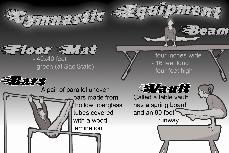The dummy’s guide to Hornet gymnastics

Click here to enlarge.:
February 27, 2007
Women’s gymnastics isn’t like any other team sport. The athletes don’t hit or kick a ball around a field to accumulate a single or double-digit score.
Yet gymnastic scores make it into the triple digit and often a team can win by 0.25 or less.
Gymnastics may also not look like a team sport, since each athlete competes on four events separately and it is common that gymnasts wouldn’t compete on every event, but only one or two.
Freshman Lauren Dyson is a key competitor on the uneven bars for Sacramento State, while freshman Eryn Stubblefield competes on all four events.
Each gymnast is individually scored and is added as a team score. Sacramento State’s women’s gymnastics team scored a season-high 193.0 in a win over Boise State on Jan. 28.
Stubblefield still has a favorite event, but it changes year-to-year. Last year it was floor, and now it’s the beam because of the challenge and the lineup.
Gymnasts perform difficult maneuvers such as a back handspring, straddle in the air or a front tuck and remain on a four-inch beam.
“We have a strong beam lineup,” she said. “It’s exciting to go do that event.”
The beam is elevated about four feet above the ground. It is 16 feet long and four inches wide. The beam also has some padding and a spring to prevent injuries.
“It’s forgiving to the legs,” Sac State coach Kim Hughes said.
The gymnasts can mount the beam from either side or end with an artistic mount or skill and will do a sequence of artistic movements and skills.
Gymnasts can split, straddle, pick and scale in the air, do a pivot turn, handstand, back handspring, tucks and much more.
Unlike Stubblefield, sophomore Marina Borisova said she doesn’t care too much about the beam.
“I can do it, but I need more confidence,” she said.
Dyson was recruited for skill on the bars and, while she loves competing on the bars, has competed on the beam and floor for the Hornets as well.
Someone who has a fear of heights or falling shouldn’t compete on the uneven bars. Gymnasts can fall flat on their bellies after the convert from the lower bar to the high bar.
The bars are a pair of parallel uneven bars, which are made of hollow fiberglass tubes with wood lamination covers.
Gymnasts can mount the bars from the higher bar, but most either mount the lower bar or jump from a springboard to bypass the lower bar and go straight to the higher bar.
The gymnasts will do a sequence of loops, releases and handstands between the high and the low bar to gain momentum for the dismount.
Senior Sara Williams and junior Alexis Tsurumoto are two Sac State gymnasts who compete strictly on the bars.
“(Bars) comes naturally to me,” Tsurumoto said.
Tsurumoto is currently injured, but said she may be competing as early as February 20.
“I’m so confident on bars it’s comfortable (to compete),” she said.
Tsurumoto has also been working on the beam, but said she gets a bit nervous.
This season is the first time Williams has competed on vault, and looks to co-captain Nicole Giao for some guidance.
A major part of competing in the vault event has to do with running. When people think of running, sports such as track, soccer, baseball and cross-country come to mind, but not a sport where an athlete has to run approximately 80 feet indoors towards a stationary object.
Chris Lane, a senior majoring in business said when he thought of a running sport, soccer, football and track came to mind. He didn’t think gymnasts run in meets. “Maybe for training, but it doesn’t seem like it competition wise,” Lane said. The vault is a stationary object called a vault table, on which both men and women can compete. It was originally called a tongue, because it looked like one, but it’s rarely called by that name anymore. An 80-foot carpet extends down a path, where the gymnasts set up for the event.
Giao said she begins her vault between 71 and 72 feet from the table.
The purpose is to run towards the vault, jump onto the springboard, catapulting over the vault, and stick the landing.
“They come easy to me. It just makes sense,” Giao said of competing on vault and floor.
She said she is what her coaches call a “power gymnast,” since she is quick.
The final event is the floor, which is the only event where a gymnast must remain in a certain area and is assisted by music. The gymnasts are required to stay in bounds or their score will be docked.
The 40-by-40 foot floor is made from different materials with springs underneath the traditional blue carpet, but to support the Sac State spirit, the Hornets compete on a green carpet.
Most universities have school colors for the floor rather than the common blue, Hughes said.
Gymnasts do a combination of dance-type sequences and tumble passes from corner to corner.
Borisova said she loves the floor rotation simply because she’s good at it.
“I can do it anytime,” she said.
Karyn Gilbert can be reached at [email protected]




























































































































